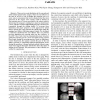Free Online Productivity Tools
i2Speak
i2Symbol
i2OCR
iTex2Img
iWeb2Print
iWeb2Shot
i2Type
iPdf2Split
iPdf2Merge
i2Bopomofo
i2Arabic
i2Style
i2Image
i2PDF
iLatex2Rtf
Sci2ools
ICRA
2008
IEEE
2008
IEEE
Human-guided surgical robot system for spinal fusion surgery: CoRASS
— There are two main limitations in the conventional robot-assisted spinal fusion surgery. Since the end effector in the state of art has a role of guiding the insertion pose of a screw only, i) convenience that can be obtained when the robot intervenes in the surgery more actively could be limited. ii) The insertion pose of a screw provided by the robots could be deteriorated by surgeon’s resisting force since he should insert a screw with his own hand withstanding the large reaction force transmitted through the drilling handle. To overcome those limitations, this paper proposes a novel approach for spinal fusion, wherein the robot performs the spinal fusion using the equipped end effector following surgeon’s guide. We developed a dexterous small-sized the end effector that can perform previous gimleting and screwing tasks into the vertebrae. A five-DOF robot body that has kinematically-closed structure guides the insertion pose of a screw and resists strong reaction force fi...
End Effector | ICRA 2008 | Insertion Pose | Robotics | Spinal Fusion |
| Added | 30 May 2010 |
| Updated | 30 May 2010 |
| Type | Conference |
| Year | 2008 |
| Where | ICRA |
| Authors | Jongwon Lee, Keehoon Kim, Wan Kyun Chung, Seungmoon Choi, Young Soo Kim |
Comments (0)

